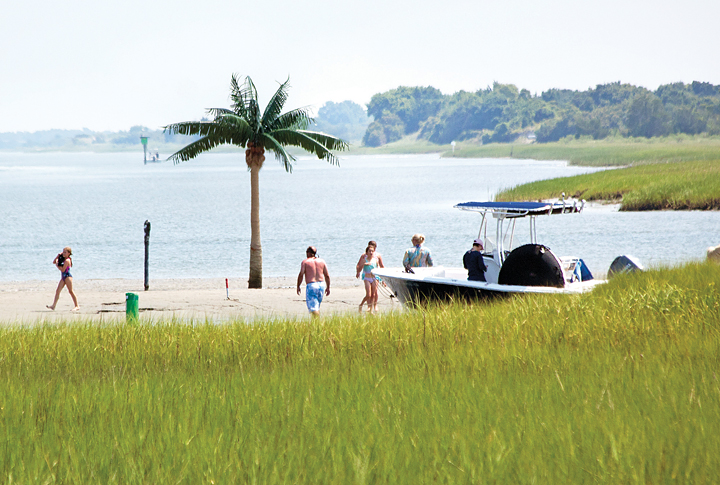The stories behind Wrightsville’s unique landmarks uncloak the mystery that sometimes shrouds the history, and more often the whimsy, of beach-town living.
Palm Tree Island
Beachgoers crossing the Heide Trask Drawbridge into Wrightsville Beach might notice a lone palm tree and a single parking meter sprouting out of the Intracoastal waterway to the north. Only at low tide is Palm Tree Island revealed, drawing a regular crew of boaters in the know.
One of those boaters, Dr. Bill Salling, said the palm tree first appeared around the year 2000.
“Local lore has it … some folks were debating which was better: Wrightsville Beach or the Bahamas,” Salling stated in a June 25 email. “Wrightsville Beach was hands down the winner, except the Bahamas have little tiny islands with palm trees.”
The locals realized they did have a small island in the ICWW, at low tide, so all they needed was a palm tree. In the middle of the night, they planted the palm and it — or one of its successors — has been there ever since.
“The parking meter came later, compliments of an eccentric engineer from Middle Sound,” Salling added. “He figured there were parking meters everywhere else, so there might as well be one with a boat cleat on a sandbar.”
The island is known as The Diminishing Republic, and every Memorial Day Saturday, as the tide recedes and the tiny spot of sand appears, locals gather to celebrate the start of summer.
“The idea is to fill it with enough people to eventually sink the island, hence the name, The Diminishing Republic. Happens every time — twice a day,” Salling said.
Following the trolley
More than a century separates modern-day Wrightsville Beach from the moment the electric trolley first clattered over the Causeway Bridge, bringing visitors to sunbathe on the beach strand or to dance at Lumina Pavilion. But today, signs along the trolley route, now South Lumina Avenue, inconspicuously mark the seven stops the trolley made on its journey south.
Each colorful sign includes a plaque describing which hotel, restaurant or club stood near the station, offering present-day island visitors a glimpse into the culture and landscape of the beach in the early 1900s.
Asphalt has replaced trolley tracks and a slew of new landmarks and residences now grace the island, but, Wrightsville Beach Museum Executive Director Madeline Flagler noted, the houses are still numbered between the trolley stops rather than the cross streets.
In the Loop
Every morning in Wrightsville Beach, the John Nesbitt Loop is filled with a steady stream of walkers and joggers. The 2.45-mile sidewalk serves as a community hub for the island, and, decades ago, it was a community effort that created it.
John Nesbitt started working as the Wrightsville Beach public works director in 1979, Flagler said during a June 25 interview. He knew the town needed a sidewalk around Harbor Island and the beach strand, but there wasn’t money budgeted the project.
Nesbitt built the sidewalk, square by square, at almost no cost to the town. As construction workers finished other projects around the island, Nesbitt asked them to use their leftover cement to create the Loop sidewalk, section by section, Flagler said.
Nesbitt retired from his job as public works director in 1999. In 2006, after his death, the Loop was officially named for him.
Leave a note
Easter Sunday, 2003, Bernard and Sidney Nykanen trekked out to the north end of Wrightsville Beach and installed a 7-inch tin mailbox near the dunes. A message on the front of the mailbox encouraged passersby to “Leave a note” on the pages of the journal within.
For over a decade, the mailbox clung to the tip of the island, collecting 125 journals of confessions, prayers and thoughts inspired by the secluded stretch of sand. It withstood multiple hurricanes over the years, but its undoing was, in the end, manmade.
The Nykanens removed the mailbox in 2014 after another one of their projects, a wooden bench built from 300-year-old Cape Fear River wood planks, was vandalized.
Less than two months later, University of North Carolina Wilmington students decided to carry on the Nykanens’ efforts. Sunday, April 27, 2014, the UNCW Student Ambassadors planted a new mailbox in the exact location of the old one, with the same scrawled invitation on the front: “Leave a note.”
The 60 members of the organization plan to maintain the mailbox and stock it with fresh journals to collect thoughts and wishes for years to come. Meanwhile, the original mailbox and its first 125 journals have found a final resting place at the Wrightsville Beach Museum of History on West Salisbury Street.
email [email protected]




